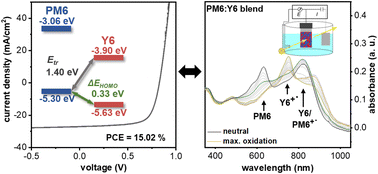Spectroelectrochemically determined energy levels of PM6:Y6 blends and their relevance to solar cell performance†
Abstract
Recent advances in organic solar cell performance have been mainly driven forward by combining high-performance p-type donor–acceptor copolymers (e.g.PM6) and non-fullerene small molecule acceptors (e.g.Y6) as bulk-heterojunction layers. A general observation in such devices is that the device performance, e.g., the open-circuit voltage, is strongly dependent on the processing solvent. While the morphology is a typically named key parameter, the energetics of donor–acceptor blends are equally important, but less straightforward to access in the active multicomponent layer. Here, we propose to use spectral onsets during electrochemical cycling in a systematic spectroelectrochemical study of blend films to access the redox behavior and the frontier orbital energy levels of the individual compounds. Our study reveals that the highest occupied molecular orbital offset (ΔEHOMO) in PM6:Y6 blends is ∼0.3 eV, which is comparable to the binding energy of Y6 excitons and therefore implies a nearly zero driving force for the dissociation of Y6 excitons. Switching the PM6 orientation in the blend films from face-on to edge-on in bulk has only a minor influence on the positions of the energy levels, but shows significant differences in the open circuit voltage of the device. We explain this phenomenon by the different interfacial molecular orientations, which are known to affect the non-radiative decay rate of the charge-transfer state. We compare our results to ultraviolet photoelectron spectroscopy data, which shows distinct differences in the HOMO offsets in the PM6:Y6 blend compared to neat films. This highlights the necessity to measure the energy levels of the individual compounds in device-relevant blend films.



 Please wait while we load your content...
Please wait while we load your content...